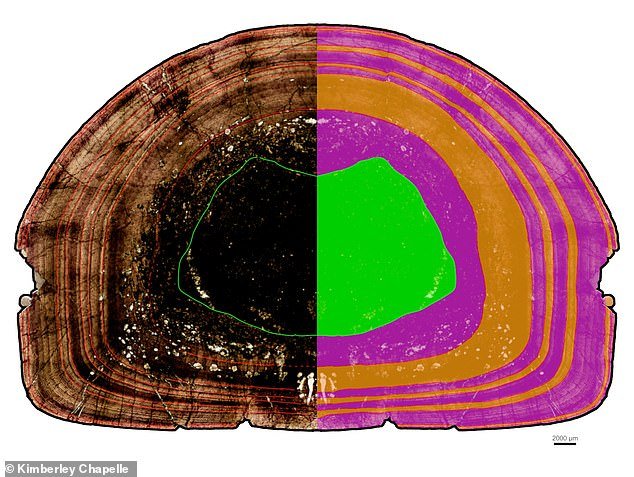The dinosaur that grew like a TREE: Analysis of 200million-year-old South African creature’s bones reveals its growth varied season-to-season — more like a plant than a puppy or a baby human
- Massospondylus carinatus was a plant-eating dinosaur from the early Jurassic
- Experts from American Museum of Natural History studied its fossil thigh bones
- They counted growth rings in the bones to determine how it grew with time
- Like trees, the researchers found its growth varied significantly over its life
- This strategy likely allowed it to adapt to changing environmental conditions
- M. carinatus adults could reach up to 1,100 lbs in weight and 13–20 feet long
Talk about growth spurts! The fossilised bones of a 200 million-year-old dinosaur from South Africa have revealed that its development varied from season-to-season.
Unlike humans or puppies, which tend to grow in a broadly steady fashion, ‘Massospondylus carinatus‘ grew irregularly, much in the way that trees do.
In fact — just like you would for a tree — researchers led from the American Museum of Natural History studied the dinosaur’s thigh bones by counting growth rings.
They found different thicknesses of rings for different years, which the team believe was a growth strategy to adapt to varying environmental conditions.
Talk about growth spurts! The fossilised bones of a 200 million-year-old dinosaur from South Africa have revealed that its development varied from season-to-season. Pictured: a cross section of a Massospondylus carinatus thigh bone, with colourations (right) highlighting the different thickness of growth rings seen within
The study was undertaken by palaeontologist Kimberley Chapelle of the American Museum of Natural History and her colleagues.
‘These things were just all over the show,’ said Dr Chapelle.
‘One year they might gain 100kg [220.5 lbs] of body weight and the next year they’d only grow by 10kg [22 lbs]!’
A medium-sized dinosaur, Massospondylus could reach up to around 1,100 lbs (500 kg) in weight.
It is thought to have enjoyed a diet of plants like ferns.
According to Dr Chapelle and her team, Massospondylus’ growth patterns were likely a product of its environmental conditions.
In a good year with plenty of rain and food, for example, growth would proceed unfettered.
This would allow the dinosaurs to almost double their size.
On the other hand, nutrient-scarce years might mean that the creatures hardly grew larger at all, as to conserve their limited resources.
Such an approach might have helped Massospondylus cope with the harsh environmental conditions it encountered 200 million years ago, in the wake of the end-Triassic extinction that saw more than half of all species wiped out.
‘Massospondylus was one of the first Southern African dinosaurs named back in 1854 and we are still learning so much from it,’ said Dr Chapelle.
‘It teaches us so much about our past environments and what southern Africa was like 200 million years ago.’

A medium-sized dinosaur, Massospondylus (pictured in this artist’s impression) could reach up to around 1,100 lbs (500 kg) in weight and enjoyed a diet of plants like ferns
‘This study shows the power of big sample sizes,’ said paper author and palaeontologist Jonah Choiniere of the University of the Witwatersrand.
‘When we can study a dinosaur from embryo to adult, like Massospondylus, we can begin to understand them as living animals.’
‘It is exciting to see such varied growth patterns in a dinosaur,’ added fellow paper author Jennifer Botha of South Africa’s National Museum Bloemfontein.
This, the vertebrate palaeontologist added, ‘show[s] us there is still so much to learn about these unique creatures!’
The full findings of the study were published in the journal Biology Letters.

